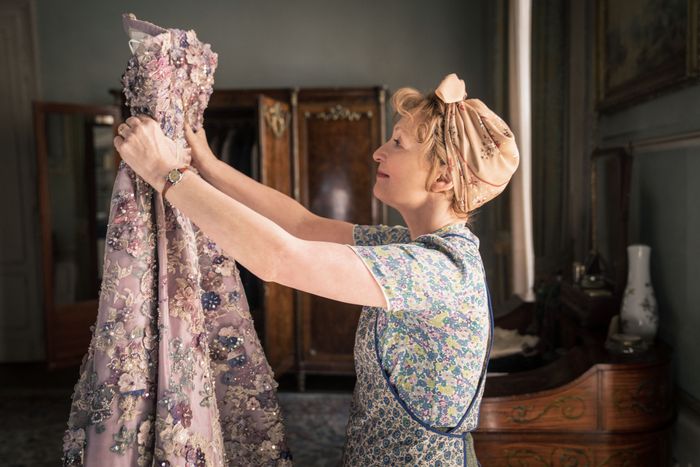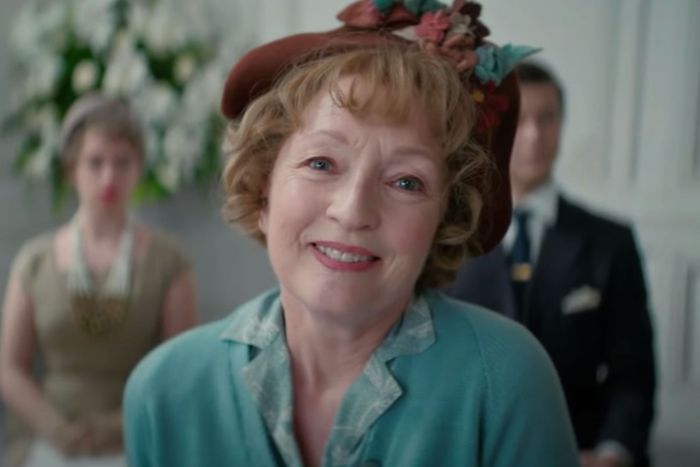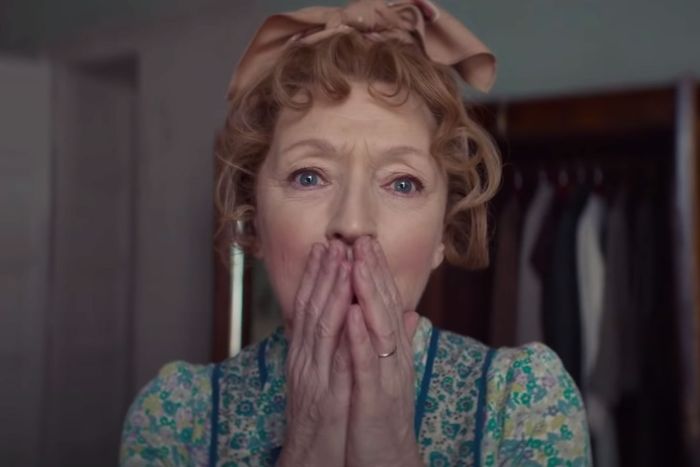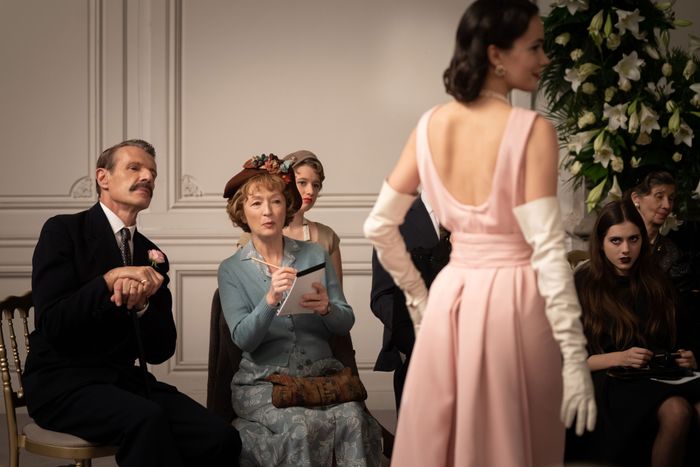
Mrs. Harris Goes to Paris is, despite its deceivingly simple premise, many things. Yes, it is about a working-class widow in postwar London traveling to Paris solely to buy a Dior gown. It is also a nicecore inversion of Phantom Thread, sharing a star in Lesley Manville and the airy aesthetics of a 1950s atelier. It employs Gump logic with its fictional lead altering the course of real history; in this case, she convinces Dior to develop non-couture products for an emerging consumer class, saving the company. Last year’s House of Gucci touched on similar territory, but where that movie disappointed in its indifference to the couture itself, Mrs. Harris makes dressmaking an A-plot and treats gowns like members of its ensemble. “The story is dresses,” says writer-director Anthony Fabian.
Fabian isn’t exaggerating. In Mrs. Harris, dresses are pivots on which the action turns. They’re Manville’s scene partners; they spark her character growth and moments of joy, awe, resolve, and grief. That’s a lot of weight to put on some tailored fabric. “Jenny always talks about clothes not as clothes but as a device to tell a story. It’s never purely about the aesthetic. It’s about, Is this telling the story in the best way that it can?” says Fabian, referring to Oscar-winning costume designer Jenny Beavan, who created 20 Dior-inspired gowns including approximations of the three most important (fictional) dresses described by Paul Gallico in his 1958 novel, Mrs. ’Arris Goes to Paris — the ones called Ravissant, Venus, and Temptation.
Ravissant is the first Dior dress Mrs. Harris, who works as a cleaning woman, lays eyes on. A full-skirted lavender number encrusted in sequins and floral appliqués, it is draped over a chair in the bedroom of one of Mrs. Harris’ employers, the wealthy Lady Dant (Anna Chancellor). When Mrs. Harris turns her attention to it, it almost begins to glow as though activated by Manville’s gaze. “Some people have described that moment as the meet-cute of the movie — you know, in a rom-com, where the two main characters meet each other for the first time and fall in love,” says Fabian. “There is almost a kind of interaction between her and the dress.” He calls the scene “a wonderful example of true collaboration,” with Beavan carefully selecting sequins and other reflective materials that would play with the light in a way that felt “magical.” “And then Felix Wiedemann, our cameraman, played with what Jenny had given him with the light.”
Beavan points out that we never see either Lady Dant nor Mrs. Harris actually wear the dress, though in one of the most beautiful moments of the movie, Manville holds the dress up against herself in the closet mirror. With her floral work shirt peeking out underneath, grounding us in where Harris is in the present, Ravissant transforms her and transforms the movie itself, freezing time in gauzy suspension. It’s a reminder that the original meaning of the word glamour was “a magic spell.” In this moment, “the screen appears to open up, and there are multiple reflections of her, and it’s almost like all the different versions of Ada that could have been or that might exist,” says Fabian. This visual establishes an openness toward the past and future that marks this movie as something special. Mrs. Harris is a widow in her 60s; this isn’t the sort of character we normally see onscreen in a role about personal transformation and someone in a state of becoming. “But what she does as an actress in that moment is suddenly lose about 20 years. There’s something in her expression — her peacefulness, her joy, her absolute rapture — that makes her ravishingly beautiful in that moment, and that’s the impact that the dress has on her soul, on her psyche, in a way.”
If Ravissant is the movie’s call to action, then the Dior fashion show is the big action set piece. For a few visually sumptuous minutes, Mrs. Harris sits among an audience of wealthy Parisian buyers at a Dior fashion show. The scene showcases 20 looks based on archival Dior, including five gowns lent from the house’s heritage collection, “which are not original pieces from the ’50s but pieces they’ve remade,” Beavan explains. She and her team re-created the other 15 looks, many of which had only black-and-white photographs as reference points. “It was very, very important to get color into the palette of the show,” Beavan says. “The whole point is that it’s got to be pieces Mrs. Harris thinks are wonderful.”
And she certainly does. The magic of this scene, of a woman sitting in a chair looking at dresses, is that Fabian, Beavan, and Manville manage to make it captivating cinema. Mrs. Harris gasps and swoons at each look that comes through the door. Sometimes she mutters praise under her breath or breaks into small applause. Fabian staged the scene to get that breathless performance out of Manville. “I think a lot of Lesley’s reactions were really genuine because we ran the show as though it were a real show. We did it in the sequence that you’re pretty much seeing it in,” he says. “The girls were changing in between — we had to stop a little bit if the change was too quick — but we really did try to run it as a fashion show.”


The whole scene is a depiction of what it feels like to be totally enraptured by beauty. It’s not enough to showcase the looks; the scene has to communicate how the looks make Mrs. Harris feel. “It was very, very important that the show be seen through her eyes,” says Fabian. “So everything in terms of the choice of camera angles was very much from Lesley’s point of view.” Sometimes this means “extraordinarily intimate” POV moments, as when the model Natasha (Alba Baptista) gives a little nod to Mrs. Harris as she walks by in the show’s final look, a wedding dress. Others are more ornamental and abstract, as when the red Temptation dress is shot twirling overhead, fanned out in quadruple vision. It looks like an image from a Busby Berkeley musical and references an earlier shot of Mrs. Harris clutching Ravissant, inviting the viewer into her fantasy. Temptation is based on Diablotine, a red-sequined gown from Dior’s 1957 collection that Beavan adapted for Manville’s character. “If you have bright red, it’ll just look crass,” she says. Temptation had to look appropriate for an older protagonist but still alluring enough to be the film’s glamorous apex. So Beavan sequined the dress for cinematic effect but added a layer of black tulle to soften the overall look. They paired the dress with a removable bolero top to give Manville “two looks out of one” and therefore two opportunities for an outfit reveal (one for the whole crowd and one just for Jason Isaacs’s character, Archie).
But the dress that sees the most action by far in Mrs. Harris Goes to Paris is Venus, a green silk gown with an elaborate silvery, peacocklike appliqué along the décolletage and down the front. This is a costume with its own three-act character arc. We see it in the process of being made, in its complete form, and (spoiler alert!) singed to a raggedy crisp. It’s a costume that required many duplicates, both for the burning and tailoring scenes and for it to be worn by three different actors. Some of the loveliest scenes in the movie are of Mrs. Harris attending her fittings in the atelier; they mark her growth over her time in Paris as Venus comes further along from underpinnings to final gown. “John Bright made that dress,” says Beavan. “He’s got genuine deals in his collection, and he understands the way they are made, so when you see it in a half-dress state, it is utterly correct.” These scenes emphasize the care with which the movie treats subject matter others may see as frivolous (or totally disposable [cough] House of Gucci [cough]). “I always enjoy that it looks genuine because there are certain other films made about fashion where you feel its people haven’t quite understood the methodology.”
Fabian says this attention to accuracy serves the story as much as it made scenes like the fitting, the fashion show, and the first confrontation in the anteroom credible. “Ada is a fantasy character, but Dior is a real fashion house, so we needed to make the reality of it real for the fairy tale to truly work. And I think Dior hugely appreciated that we went to those lengths not only to recreate the dresses but also the interior of the House of Dior. We used the architectural drawings, and that was terribly important because the relationship between the different spaces was critical to the scenes.” The stark-white atelier interiors and crisp white coats of the seamstresses in these scenes allow Mrs. Harris to completely pop in Venus; she transforms as much as the dress does in each tailoring session. “Lesley has often said that that scene of her fitting is one of her favorites in the way that it was filmed. She loved the whole tableau of that scene.”
The sequence in which Venus is lent to aspiring actress Pamela Penrose (Rose Williams) is both farcical and tragic, striking a difficult tonal balance. “It was dramatically necessary, I’m afraid,” says Fabian. “You always need to get your characters into much more trouble than you would ordinarily wish they would go through. In fact, Paul Gallico has a terrible tendency to rescue his characters too soon. As a screenwriter, we had to find ways of increasing the stakes and increasing the obstacles rather than clearing her a path.” The answer, naturally, was to set the dress aflame. This is a devastating moment not only for Mrs. Harris but, I realized, also for Beavan. Between Mrs. Harris Goes to Paris and last year’s Cruella, her careful artistic work has a horrible tendency to get set on fire.
“For goodness sake!” she says when I bring it up. “I blame that entirely on the screenwriters — various — for landing me in that. And thank goodness for visual effects because I think in Cruella we did it very well. I mean, people are always asking me, ‘Did you really burn the dress?’ I’m thinking, Would you do that to Emma Stone? I don’t think so. But no, I have no idea. I’m sure we’re burning things at the moment in Mad Max.” Flames and destruction aside, Beavan thinks Mrs. Harris Goes to Paris couldn’t be timelier or more essential. “It is a film for everyone, and at a wonderful time, with the world sort of collapsing, it’s exactly what you need.”
More From This Series
- How The Penguin Styled Sofia Falcone’s Gigante Transformation
- ‘How Can We Make It Campier?’
- ‘Her Glow-Up Is Her War Regalia’



